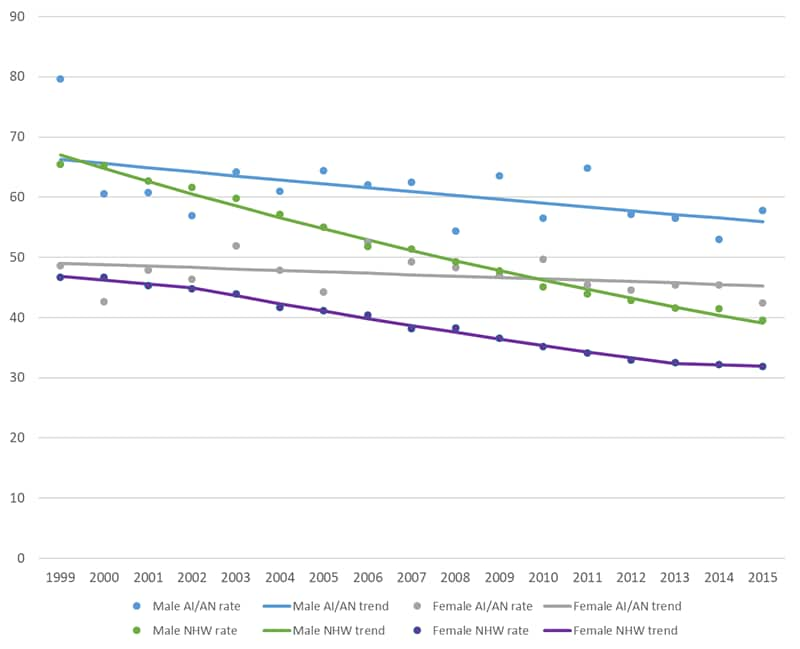Colorectal Cancer in the American Indian and Alaska Native Population, United States—2011–2015 (Purchased/Referred Care Delivery Areas)
U.S. Cancer Statistics Data Briefs, No. 7
May 2019
This data brief uses the most recent data available at the time of publication. More recent data may be available in a newer data brief or in the U.S. Cancer Statistics Data Visualizations tool.
Purchased/Referred Care Delivery Areas (PRCDA) are counties that contain federally recognized tribal lands or are adjacent to tribal lands. Race classification for the American Indian/Alaska Native (AI/AN) population is more accurate in these counties.
Colorectal cancer is cancer that occurs in the colon and rectum. Common risk factors include—
- Age over 50 years.
- Alcohol consumption, cigarette smoking, lack of physical activity, a low-fiber and high-fat diet, a diet high in red and processed meats, and overweight and obesity.
- Inflammatory bowel disease, diabetes, or a personal or family history of colorectal cancer.
The AI/AN population experiences excess colorectal cancer in many regions. Early detection of colorectal cancer through screening can help to reduce mortality.
Rates by Sex and Region
Figure 1. Age-Adjusted Colorectal Cancer Incidence Ratesa by Region: PRCDA, 2011–2015
aRates are per 100,000 and age-adjusted to the 2000 US standard population.
bIndicates age-adjusted rates in the AI/AN population are significantly different than the non-Hispanic White population living in PRCDA counties.
Colorectal cancer rates—
- Were higher overall in the AI/AN population compared with the non-Hispanic White population (57.7 vs. 41.8 in males; 44.6 vs. 32.7 in females).
- Varied by geographic region in the AI/AN population, with the highest rates in Alaska for both genders.
- Were significantly higher in the AI/AN population compared with the White population in the Northern Plains, Alaska, Southern Plains, and Pacific Coast regions for males and females.
Rates by Age Group, Sex, and Region
Figure 2. Age-Adjusted Colorectal Cancer Incidence Ratesa by Region and Age Group, PRCDA, 2011–2015
A. Men
B. Women
aRates are per 100,000 and age-adjusted to the 2000 US standard population.
bIndicates age-adjusted rates in the AI/AN population are significantly different than the non-Hispanic white population living in PRCDA counties.
Colorectal cancer rates—
- Were higher overall in all age groups for AI/AN males and females compared with the White population.
- Were highest in the Northern Plains in AI/AN males younger than 50 years.
- Were highest in Alaska in AI/AN males older than 50 years and AI/AN females in all age groups.
Trends by Sex
Figure 3: Annual Age-Adjusted Colorectal Cancer Incidence Ratesa and Trend Lines,b AI/AN versus Non-Hispanic White, by Sex, PRCDA, 1999–2015

- Male Non-Hispanic White (1999–2015: -3.3*)
- Male American Indian/Alaska Native (1999–2015: -1.1*)
- Female Non-Hispanic White (1999–2002: -1.4; 2002–2013: -2.9*; 2013–2015: -0.6)
- Female American Indian/Alaska Native (1999–2015: -0.5)
aRates are per 100,000 and age-adjusted to the 2000 US standard population.
bTrend lines were calculated using Joinpoint regression analysis.
*The annual percent change is significantly different from zero (p<0.05).
Colorectal cancer trends include—
- Overall, colorectal cancer rates have declined significantly for AI/AN males, but have plateaued for AI/AN females in recent years.
- In AI/AN males, colorectal cancer rates decreased significantly in the Northern Plains (1999–2015 APC: -3.3) and Pacific Coast (1999–2015 APC: -2.1), but increased significantly in the Southwest (1999–2015 APC: 2.2). (Data not shown in graphs.)
- In AI/AN females, colorectal cancer rates decreased significantly in the Northern Plains (1999–2015 APC: -2.1) only, with a significant increase in the Southwest (1999–2015 APC: 4.0). (Data not shown in graphs.)
Data Source
Data are from the United States Cancer Statistics American Indian/Alaska Native Incidence Database (USCS AIAD). This database includes data from cancer registries participating in CDC’s National Program of Cancer Registries and the National Cancer Institute’s Surveillance, Epidemiology, and End Results program that have been linked with the Indian Health Service patient registration database. The USCS AIAD and PRCDA counties have been described previously.1 These linkages address racial misclassification of the AI/AN population in the central cancer registries. These data met quality criteria2 for 2011–2015.
References
1Espey DK, Wiggins CL, Jim MA, Miller BA, Johnson CJ, Becker TM. Methods for improving cancer surveillance data in American Indian and Alaska Native populations. Cancer 2008;113(5 Suppl):1120–1130.
- USCS Data Visualizations Tool
- Colorectal (Colon) Cancer
- National Comprehensive Cancer Control Program (NCCCP): The NCCCP funds all 50 states, the District of Columbia, 6 US Associated Pacific Island and Puerto Rico, and 8 tribes or tribal organizations to establish coalitions, assess the burden of cancer, determine priorities, and develop and implement comprehensive cancer control programs.
Centers for Disease Control and Prevention. Colorectal Cancer Incidence in the American Indian and Alaska Native Population, 2011–2015 (Purchased/Referred Care Delivery Areas). USCS Data Brief, no. 7. Atlanta, GA: Centers for Disease Control and Prevention; 2019.